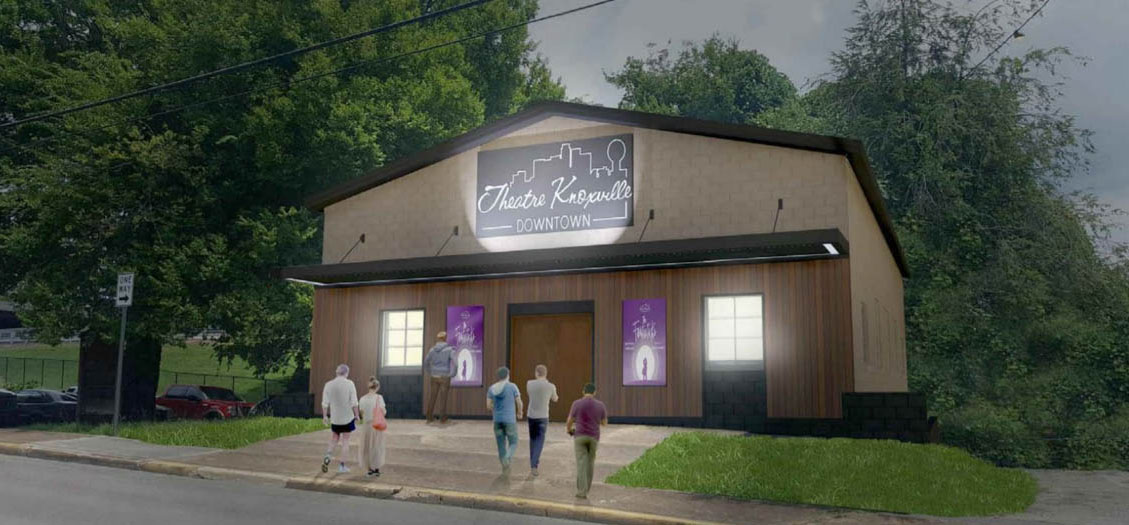Urban renewal—if one can still use that term today with a straight face—has not been kind to 800 South Central Street. A mere two blocks east of the bustle of Gay Street, and on the now lonely corner of S. Central and Cumberland Avenue, is a plain, but solid-looking building that bears all the signs of having been lost in time. Built in 1956, the concrete block structure served as a church for different religious organizations during most of that time, but has been unused for several years. However, if the wildly successful revitalization of Downtown Knoxville in the last 15 years has taught us anything, it is that neighborhoods can change and buildings can have new life. And, importantly, the arts can be the catalyst.
At one time, a lot of Knoxville history would have passed by that corner. Although now a dead end, the Cumberland Avenue of history came down the hill from Gay Street and continued east, crossing First Creek on a bridge, then ascended the slope to intersect with streets now found only on old maps and in the memories of former residents.
Only a few years after 800 S. Central’s construction in the mid-50s, its neighborhood began to change. Knoxville’s infamous urban renewal project of the late 50s and early 60s removed whole streets and neighborhoods to make room for the Civic Auditorium/Coliseum/Municipal Building; the eastern leg of Cumberland was one of the notable victims. Later, adding insult to injury, the morphing of the Downtown Business Loop into the James White Parkway and the Neyland Drive access added overhead ramps pushing the historic Main and Cumberland avenues callously to the side. Long-abused First Creek was forced into an underground channel, terminating Cumberland Avenue forever at the spot, leaving the southern portions of S. Central with few prospects.
Today, however, those prospects have brightened considerably with a new use for that concrete building at 800 S. Central. Theatre Knoxville Downtown, chartered in 1976 and professing to be the city’s longest continually operating community theatre organization, has taken a lease on the building as its new home and is currently remodeling the space to fit its performance needs. Having grown beyond the conditions and 50-seat capacity of its previous space at 319 North Gay Street that it had occupied since 2005, TKD began a “Second Act Campaign” in August 2015 to raise funds that would allow a move and construction of a new theatre space.
The non-profit TKD’s Board of Directors, led by president Bonny Pendleton and vice-president Joseph Jaynes, originally looked at 213 E. Fifth Avenue, the current location of Carmichael Automotive Repair Center, an address that is scarcely a third of a mile from TKD’s old N. Gay location. With that site a possibility, the East Tennessee Design Center drew up preliminary plans for the space, but construction estimates to convert it into a theatre greatly exceeded TKD’s budget and fundraising. Re-opening search efforts, TKD’s realtor, John Lyle of Coldwell Banker, suggested they examine the 800 S. Central building, which, as a former church, offered the basic structure for a theatre. A lease was arranged with the property’s new owners, Stephanie and Russell Balest. The Balests have agreed to make physical improvements to the building’s exterior and facade.

Inside, the job of converting the former church into a theatre space has fallen on Steve James of Ghost Riders Metal Works who is acting as the project’s general contractor as well as supplying many of the project’s construction services. Theatre-specific renovations include building code-related improvements, a new stage and proscenium wall, an electrical service and grid for stage lighting, audience restrooms, and new heating and air conditioning systems. TKD is refurbishing the church pews to use as audience seating in the short term—seating that will roughly double the capacity of their old location. Pendleton suggests that one advantage of the larger space will be the ability to select plays with larger casts and more extensive scenic requirements than have been previously possible.

Hitches notwithstanding—slight or otherwise—audiences for that April opening will have to acquaint themselves with getting to the new location on street segments that may be unfamiliar to many drivers. Parking, however, should be no issue during the evening, as TKD has some onsite parking to the north and adjacent lots may be made available to theatre patrons. The Dwight Kessel Garage, offering free parking at night and on weekends, is only one block to the south. Of course, pedestrians can venture the two blocks down the hill from Gay Street.
There is an old familiar joke that starts with complaints and ends with the punchline “…What? And give up show business?” That joke reveals the kind of passion that inhabits those that are infected with the art of performance and stagecraft—those that have “theatre” in their blood. Given their track record of perseverance over the years, Theatre Knoxville Downtown belongs squarely in that group. It’s now intermission for TKD, but they are hoping their audience will follow them on to their Second Act at 800 S. Central Street—and allow that lonely corner to see life once again.







